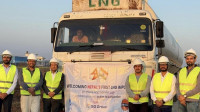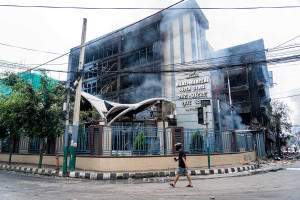Money
Here’s everything you need to know about Nepal Airlines’ Airbus deal
The country’s national flag carrier, Nepal Airlines, has been involved in a series of corruption cases involving aircraft sale and lease in previous years. One recent trend that has garnered widespread media attention is the procurement of two wide-body Airbus A330 jets.
Sangam Prasain
The country’s national flag carrier, Nepal Airlines, has been involved in a series of corruption cases involving aircraft sale and lease in previous years. One recent trend that has garnered widespread media attention is the procurement of two wide-body Airbus A330 jets. The corporation purchased two A330-200 Airbus aircraft from the US-based AAR Corp for $209.6 million, the largest ever aircraft purchase deal in Nepal’s aviation history.
First of the two wide-body aircraft—Annapurna—arrived at the Tribhuvan International Airport in June. The second named, Makalu, arrived a month later.
Two parliamentary committees—Public Accounts Committee (PAC) and International Relations Committee—are currently conducting an investigation into the controversy. There are many conflicting claims: the Ministry of Tourism claimed the jet purchase deal was transparent as all due process has been followed, while the audit report from the Auditor General’s office claims that the corporation breached its own financial bylaw during the procurement process. Some publications have reported that the corporation doesn’t possess the ownership certificates of the planes and that the plane was leased, not fully procured.
On Wednesday, after four rounds of deliberations over the purchase of the A330 jets, the PAC came to the conclusion that there was no issue in terms of ownership and lease agreement and decided to focus its investigation on the procurement process and the financial part of the deal.

When did the deal begin and when it ended is really important, but it is also equally confusing to follow for those who don’t know the history that led up to this historic purchase. Here are the most basic answers to your most basic questions:
How did the Nepal Airlines’ purchase deal begin?
On May 28, 2015, the Cabinet reappointed Sugat Ratna Kansakar as the managing director of NAC for a four-year term. Although the Public Enterprises Directorate Board (PEDB) used to oversee the appointment of the chief at NAC, at the behest of the then Finance Minister Ram Sharan Mahat, the rule was relaxed allowing political appointment.
In August 2015, under the leadership of Kansakar, NAC began the process of acquiring two wide-body aircraft from the European plane maker. On September 11, 2016, the Finance Ministry agreed to act as a guarantor on a loan NAC plans to take to procure two widebody jets.
Was there a reason why Airbus A330-200 was chosen?
On September 24, 2016, the board of Nepal Airlines Corporation unanimously approved its management’s plan to procure two Airbus A330-200 wide-body jets. Subsequently, on September 26, 2016, NAC invited sealed requests for proposals (RFP) from aircraft manufacturing companies, airlines, aircraft leasing companies and bankers for the purchase of two A330-200 jets.
The bid documents said the minimum age of the proposed aircraft cannot be more than 1,000 flight hours and the date of manufacture should not be before January 2014. It was informed that the board’s move to allow NAC to buy the jets from the European aviation giant follows the management’s recommendation to switch to Airbus from Boeing as pursuing a one-family aircraft strategy would reduce maintenance and crew training costs. NAC plans to have an all-Airbus fleet in the near future.
Why did the corporation want second-hand planes?
There was no logical explanation for this, but Kansakar said that there was no slot for ordering brand new planes for three years regardless of who ordered the aircraft from the manufacturer. However, a close source close to the deal told the Post that one leasing company (Portugal-based Hi Fly), had two jets financed by German Capital and was looking for a buyer after the earlier party cancelled the deal. Accordingly, the requests for proposal documents were prepared and floated.
When the final deadline ended on November 10, 2016, 11 international firms submitted bids to supply two long-range wide-body passenger jets to NAC. The suppliers were Rolls-Royce, KL AeroParts, Aircraft Investment Group, Crown Commercial Services, Synergy Aerospace, ST Aerospace, Le Group Delta, AAR Corporation, Surya Air Support, KJT Investment & One World Closeouts and Ron Motta Associates Aircraft Sales & Parts. Rolls-Royce had applied to supply the aircraft engine.
On April 7, 2017, NAC signed the final purchase agreement for two Airbus A330-200 jets from US-based AAR Corp. The $209.6-million contract for two A330-200 jets marked the largest-ever jet purchase deal in Nepal’s aviation history.
Did things get delayed?
The airlines official, who spoke to the Post on condition of anonymity, said that due to the delay in obtaining loans from the Citizen Investment Trust (CIT) and Employees Provident Fund (EPF), the NAC was not able to bring the earlier planned planes. The Nepal Rastra Bank had also delayed the foreign exchange facility for NAC for a couple of weeks. Similarly, the then Tourism Minister Jeevan Bahadur Shahi also delayed the recommendation for the foreign exchange facility as he suspected some fishy in the deal, the source said. The minister had questioned the mismatch in manufacturer’s serial numbers as the numbers “1845” and “1854” assigned by Airbus did not exist.
On Wednesday, the PAC meeting said that the initial manufacturer’s serial numbers “1845” and “1854” that NAC had claimed to be its own was actually of Tibet Airlines and Spain’s Iberia Airline respectively. In the assembly line, the manufacturer’s serial number, however, was “1872” and “1878”.
The official said that the leasing company did not wait for the NAC due to the delay in releasing the money and the jets with earlier specification was sold.
Were the jets that arrived in Nepal the same ones that were ordered?
After the request for proposal was issued, NAC’s managing director held a press meet confirming that the first of the two planes would arrive in September 2017 as they were already prepared. The delivery date was revised to January 2018. However, the first plane arrived on June 28. During a PAC meeting, Kansakar flipped his tongue and claimed that they had actually planned to buy old planes and were lucky to receive brand new planes.
But the Office of Auditor General questioned Kansakar’s motive behind bringing new planes while it had ordered old ones. Last September, Auditor General Tankamani Sharma said that the NAC had breached its own financial bylaw while procuring two
wide-body aircraft. The NAC was required to invite proposals only from the aircraft manufacturers to purchase brand new aircraft as per Clause 236 (1) of its financial bylaw. However, it went with Clause 236 (2) of the bylaw which allows the NAC to procure an old plane. As per Clause 236 (2), the carrier could get a supply of aircraft from a leasing agency, banker or airline operator besides manufacturers.
In the request for proposal, the NAC allowed bidders to supply Airbus aircraft having flown not more than 1,000 hours. This enabled the US-based AAR Corp to participate in the bidding process.
“Our question is why the procedure for purchasing an old aircraft was adopted if it had to purchase a brand new aircraft,” Sharma told the PAC meeting.
So how did Hi Fly X Ireland get involved?
In June 2017, Hi Fly had placed its first direct firm order with Airbus for two A330-200s during the Paris Air Show. The company formed a special purpose vehicle — Hi Fly X Ireland — to specifically look into the procurement process. “It’s a big question here. It’s because Ireland is the biggest tax haven in the world used by multinationals to shelter profits,” said the official, who added that as NAC did not receive the planes as planned, Hi Fly would need to pay income tax on its additional order.
“As a result of the new orders, the specifications like maximum takeoff weight and the manufacturing serial numbers of the aircraft, including other specifications did not match with what was initially ordered,” the official said.
So where is the two billion rupees?
The American aviation support company AAR had quoted an ‘offer price’ of $104.8 million for each jet. NAC officials said that the final contract price would not exceed $109 million after adjusting for inflation. Based on the exchange rate at the time of the agreement, the cost of the plane would be Rs22 billion. However, the NAC borrowed Rs24 billion from two financial entities. The PAC has also questioned on why the NAC failed to negotiate the price of the jets.
“What everyone wants to know is why the additional Rs2 billion was released by two state-owned financial institutions when they knew that each plane only costs $109 million,” the official said.




 9.12°C Kathmandu
9.12°C Kathmandu













%20(1).jpg&w=300&height=200)
